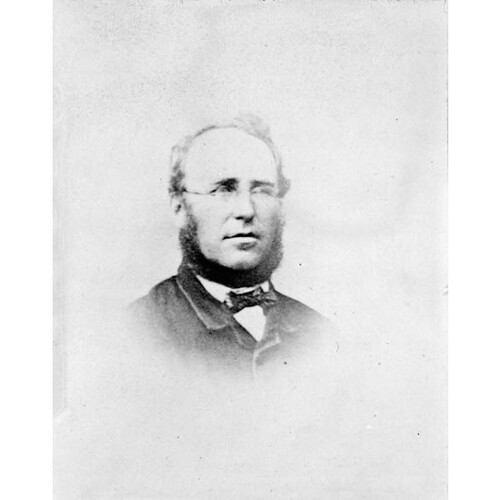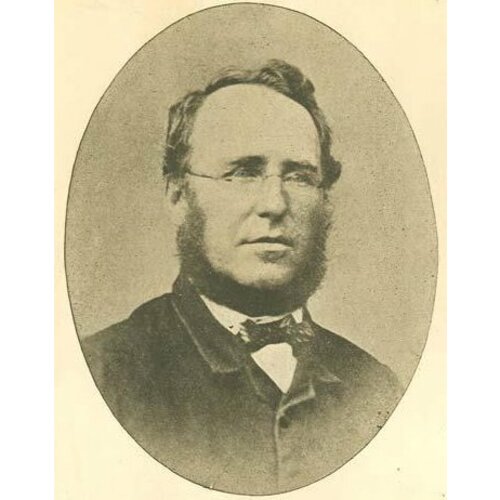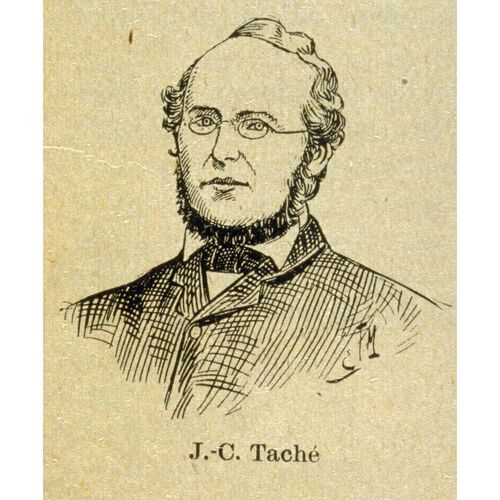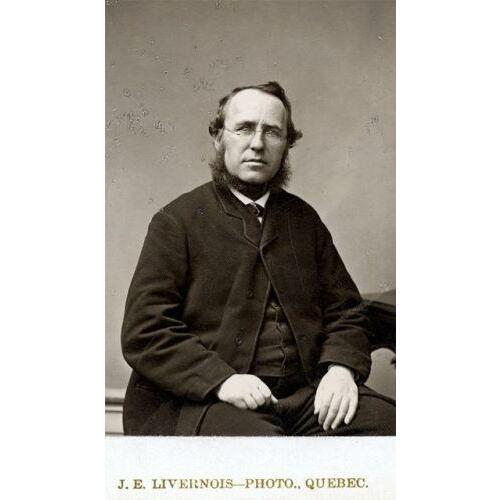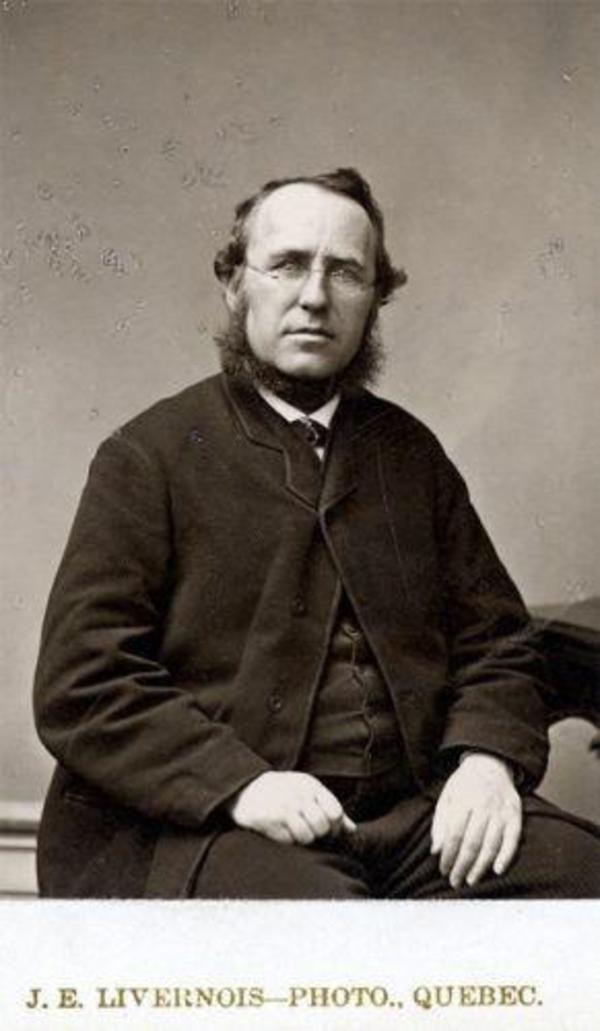
Source: Link
TACHÉ, JOSEPH-CHARLES (baptized Charles-Joseph), physician, politician, journalist, civil servant, and writer; b. 24 Dec. 1820 in the parish of Saint-Louis, Kamouraska, son of Charles Taché, a merchant, and Louise-Henriette de Labroquerie (Boucher de La Broquerie); m. 1 July 1847 Françoise Lepage in Saint-Germain-de-Rimouski, and they had six children, three of whom died at an early age; d. 15 April 1894 in Ottawa.
Joseph-Charles Taché was a nephew of Sir Étienne-Paschal Taché* and the elder brother of Alexandre-Antonin Taché. He had just turned five when his father died. His mother and two younger brothers went to live in the family manor at Boucherville, but he remained in Kamouraska with his uncle Jean-Baptiste Taché, who had become his guardian. In the autumn of 1832 he entered the Petit Séminaire de Québec. One of his schoolmates was Pierre-Joseph-Olivier Chauveau*, with whom he would later embark on his political and literary careers. In April 1840 he gave up his studies without completing his sixth year (Rhetoric), because he found the restrictions of boarding-school intolerable. After spending the rest of the year at leisure, he began an apprenticeship in medicine in January 1841 and on 16 Nov. 1844 he received his license.
Following an internship of a few months at the Marine and Emigrant Hospital in Quebec, Taché set up practice in Saint-Germain-de-Rimouski. It was an ideal location for a man of his temperament. Later known by some of his friends as “the Iroquois,” he had a passionate love of freedom, nature, and the vast expanses of wilderness to be explored. During the 12 years he practised in this region, he made a number of visits to lumber camps in the hinterland and to scattered settlements along the St Lawrence estuary. Having a strong affinity for Indigenous people and an interest in their customs, Taché was able to visit a group of them who still came to camp at the mouths of the major rivers flowing into the lower St Lawrence. From these diverse peoples he collected cultural information, legends, and true stories, which he would later use in his literary writings.
Taché soon became popular in this part of the country. On 24 Jan. 1848, at the age of 27, he was elected by acclamation, for Rimouski, to the Legislative Assembly of the Province of Canada. A supporter of Louis-Hippolyte La Fontaine*, he considered himself a “rabid,” committed Patriote. In 1842, while still a student, he had helped found the Société Saint-Jean-Baptiste of Quebec, and in 1844 he had been one of the speakers at the banquet closing the Saint-Jean-Baptiste Day festivities in that city. Like Jean Guilbault, a hero of a novel written by his friend Chauveau for whom he probably served as model, he had made a point of wearing only clothes manufactured in Canada, stubbornly refusing, out of patriotism, to buy anything imported from England. Although he never attained the political renown of his uncle Étienne-Paschal, Taché was none the less a widely respected member of the legislature, known for his wealth of political ideas and for the quality of his speeches in the assembly, which were often compelling and always carefully documented.
As representative of a remote constituency that was hard to reach, Taché naturally was interested in the development of transportation. In 1850 he submitted to the commissioner of public works, William Hamilton Merritt*, a report on his earlier proposals for improving communication by land and water. Taché wanted to make transportation for passengers and freight on the St Lawrence safer and more readily available; he also sought to have connecting roads developed along the shore and between Lower Canada and New Brunswick. As a result of these efforts he was soon made head of the legislative committee studying the bill “to regulate the Pilotage for and below the Port of Quebec,” a thorny problem not resolved until 1860, with the incorporation of the St Lawrence River pilots. Taché was instrumental also in determining the route of the Chemin de Témiscouata, which from 1856 replaced the Chemin du Portage as the link between Lower Canada and New Brunswick. He was responsible for another road, now called the Chemin Taché, a partial realization, in separate segments, of one he had suggested in his report of 1850 and drawn plans for around 1855. This road, running parallel to the Chemin du Roy but several miles inland, was supposed to cut through the forests of the lower St Lawrence and thus open them for settlement.
Taché was in the forefront during the assembly’s debate about the abolition of seigneurial tenure [see Lewis Thomas Drummond*]. Although he was opposed to abolition, he acknowledged that there were abuses in the system and that reforms were urgently needed. To counter the government’s proposed legislation, he drafted his own bill, which he published in pamphlet form and put before the assembly early in the 1854 session. He had spent several months promoting it among the members from Lower Canada. But his reforms, still very favourable to the seigneurs, could not silence the growing protests of the censitaires, who had just elected Sir Allan Napier MacNab* and Augustin-Norbert Morin* to power.
Taché’s stand in this debate undermined his popularity with voters. Having been returned by acclamation in 1848 and 1851, he narrowly escaped defeat in 1854. From then on the hostility of the Rouges intensified, partly because Taché himself was not averse to battle and missed no opportunity to use his caustic wit to discomfit the champions of the party seeking democratic reforms. This wit is evident in La pléiade rouge . . . (Montreal, 1854), a set of caricatures of his political opponents, such as Jean-Baptiste-Éric Dorion* and Charles Laberge*, which Taché published with Chauveau under the pseudonym Gaspard Le Mage and by which he established his reputation as a lampoonist. Nevertheless, he continued to lose ground in his constituency. Even his prestigious assignment to represent Canada at the universal exposition in Paris (1855) was used against him, although he fulfilled his duties there admirably and was made a knight of the Legion of Honour by Napoleon III. Conscious of the distinction accorded their member of the legislature in recognition of his abilities, the people of Rimouski gave him a fine reception on his return from Paris. However, his opponents made them even more aware of the disadvantages in having a representative more eager to obtain recognition abroad than to defend their interests with the government. Rumours of his resignation were soon circulating. Doubtless to avoid the humiliation of almost certain defeat, Taché resigned his seat in December 1856.
Shortly before, Taché had been appointed to head a new daily newspaper, Le Courrier du Canada, which was to be first issued on 2 Feb. 1857. The Canadian counterpart of L’Univers (Paris), it was intended to combat the liberal ideas the Rouges had been disseminating for some years in L’Avenir (Montreal) and then in Le Pays (Montreal) and Le National (Quebec). Taché would be a Canadian Louis Veuillot, our “Veuillotule,” as his opponents soon dubbed him. He was ideal for this role: in politics as in religion there was no doubt of his conservative convictions, and he defended them fiercely; moreover, especially after the success of La pléiade rouge, his pen was a force to be reckoned with. No stranger to journalism, he had written occasional articles for various newspapers such as La Minerve and Le Canadien, and after his election to the assembly he had been parliamentary correspondent for L’Ami de la religion et de la patrie (Quebec).
Journalism gave Taché a new and perhaps more effective platform than his seat in the assembly for defending the social and political projects he believed in, such as settlement of new lands and the ending of the union of Upper and Lower Canada. In the first issues and on several subsequent occasions, he advocated settlement as a patriotic and religious duty. It was imperative, he thought, to open up new lands for agriculture and promote their cultivation in order to stop the emigration of French Canadians to the United States, which was draining the vitality of the “race.” Indeed, every effort must be made to reverse the trend. It was essential to create conditions that would lure back those who had left the country for lack of land or in the hope of factory work that seemed more pleasant and lucrative than farming; such work led to an industrial way of life at odds with the national calling to agriculture and perilous to Christian faith and morality. These endeavours to save French Canada should be financed by reallocating much of the sum the government normally spent on promoting European immigration.
Taché used all his talents to defend another cause affecting the very life of the nation, the confederation of the British North American colonies. Like La Fontaine and his supporters, he had agreed, as a matter of practical politics, to try to make the union that had been imposed on the colony work as well as possible. None the less he continued to denounce the injustices of this system and the threat it represented in the foreseeable future to the survival of the French Canadian nation. On the other hand, he condemned annexation to the American republic, a scheme put forward by the liberal democrats, the political heirs of Louis-Joseph Papineau*, as an even greater and more certain danger. What was needed, in his view, was a system that would recognize the identity of French Canadians and give them the political power and the resources to develop this identity, while founding north of the United States a country strong enough to resist annihilation by its neighbour and to free itself before long from British tutelage. What he had in mind was the federal union of all the British colonies in North America, from Newfoundland to Hudson Bay and the North-West Territories. Taché developed his plan in a series of articles which appeared in Le Courrier du Canada from 7 July to 23 Oct. 1857 and were published in book form the following year. He was not the first to put forward a federative scheme, but there is no doubt that his was the most fully documented, detailed, and articulate proposal to be presented prior to the Quebec conference of 1864. His constitutional recommendations were based on a careful economic and sociological analysis of the situation of each colony and territory. He clearly stated the political principles underlying the clauses of the treaty of confederation he envisioned. The key concepts he had advanced were to reappear at the conference table in Quebec and the part he played in developing the constitution of 1867 deserves greater recognition.
Despite his outstanding and much appreciated commitment to his work, Taché’s contract with Le Courrier du Canada came to an end on 31 Oct. 1859. Perhaps editing a daily newspaper was too confining for a man who was by temperament a wanderer. Within a few days he assumed office as an inspector of prisons, asylums and public charities for the Province of Canada. This did not deter him from writing to further the nationalist cause; his patriotism was thenceforth directed, however, towards building up a national literature. He was deeply convinced of the importance of poetry and novels, of that “light” literature which, for friends such as Antoine Gérin-Lajoie*, was a mere pastime in comparison with the more serious and urgent business of producing scientific literature. For Taché fiction, as the reflection of the supernatural, was a basic human need. “The mind of man . . . can no more live on realism than his soul can live on the natural truths it perceives; [the mind] must venture into the unknown, [the soul] must find repose through faith in mysteries. Hence the need for our imagination to feed on magical notions. Herein lies the charm of legends and tales.” To collect and pass on to future generations the real or fictitious stories connected with the places and people of the land becomes a patriotic duty. These tales form the core of a national literature. “Like family memories, often told by the fireside, they do much to maintain the spirit of a nation in the hearts of its people and to strengthen their instinct for preservation. Religion, language, and memories are the main elements of nationality.”
These convictions led Taché in 1861 to help found Les Soirées canadiennes: recueil de littérature nationale (Quebec), which he continued to support for four years. This magazine was explicitly dedicated to building a national literature and promoting the Canadian heritage of folklore. Nearly all of Taché’s literary works made their first appearance in it. These included several poems as well as “Trois 1égendes de mon pays: l’îlet au massacre ou l’Évangile ignoré; le Sagamo de Kapskouk ou l’Évangile prêché; le géant des Méchins ou l’Évangile accepté” (1861), a fourth legend, “Le braillard de la montagne” (1864), and his most important and best-known work, “Forestiers et voyageurs; étude de mœurs” (1863), a description both factual and fictional of the daily lives of lumberjacks and voyageurs in the backwoods of Rimouski, the Outaouais, and the northwest.
Taché’s literary career was interrupted for many years when, in August 1864, he was appointed deputy minister of agriculture and statistics, an important department that also included public health. It was not until 20 years later that he managed to incorporate into a monograph entitled Les Sablons (île de Sable) (Montreal, 1885) three new legends: “Le moine des Sablons,” “Le régicide,” and “La dame au doigt sanglant.” One final legend, “La légende du lac Caché,” was published in Le Courrier du Canada on 22 June 1889.
His last and longest career, as a senior civil servant in Ottawa for 24 years, gave him even less opportunity to take part publicly in political debates (although his private correspondence leaves no doubt about his continuing interest and influence in this area). Beyond his organizational and administrative duties, he devoted himself to studies of a scientific nature related to the affairs of his department, including human and physical geography, archaeology, hygiene, and physiology. His most remarkable achievement from this period is undoubtedly the 1871 census, for which he determined the content, form, and procedure. This work has been highly praised both in Canada and abroad and is still an invaluable source of reliable information.
A key figure who was often recognized by his contemporaries for the breadth of his knowledge and the value of his diverse contributions to the emerging national culture, Joseph-Charles Taché deserves to be more widely remembered. New research should rightly accord him his due place in the political and literary history of Canada, in the development of scientific education in Quebec, and in the ongoing awakening to the authentic and irreplaceable cultural values of popular oral tradition and objects revealing the everyday life of past generations.
Joseph-Charles Taché is the author of a report on transportation in Can., Prov. of, Legislative Assembly, App. to the journals, 1850 (the French version was reprinted in Rev. d’hist. du Bas Saint-Laurent (Rimouski, Qué.), 6 (1979–80): 31–38); The seigniorial tenure in Canada and plan of commutation (Quebec, 1854), which appeared also in French both as a separate publication and in Le Canadien, beginning 5 April 1854; Esquisse sur le Canada considéré sous le point de vue économiste (Paris, 1855), partly published in Le Journal de Québec, 23–27 Oct. 1855; various papers in Canada at the Universal Exhibition of 1855 (Toronto, 1856); Des provinces de l’Amérique du Nord et d’une union fédérale (Québec, 1858), which first appeared in Le Courrier du Canada, 7 July–23 Oct. 1857, and which has been analysed by L. F. S. Upton in “The idea of confederation: 1754–1858,” The shield of Achilles: aspects of Canada in the Victorian age, ed. W. L. Morton (Toronto and Montreal, 1968), 200–2; The board of inspectors of asylums, prisons and hospitals and its accusers; letter of Mr. J. C. Taché, chairman of the board; re-printed from the “Morning Chronicle” (Quebec, 1864); Mémoire sur le choléra ([Ottawa], 1866); The Canadian census of 1871; remarks on M. Harvey’s paper published in the February number of “The Canadian Monthly” (n.p., 1871); La mouche ou la chrysomèle et les moyens d’en combattre les ravages (Montréal, 1877); Les asiles d’aliénés de la province de Québec et leurs détracteurs (Hull, Qué., 1885).
ANQ-BSLG, CE1-6, 1er juill. 1847. ANQ-Q, CE3-3, 24 déc. 1820. ASQ, Fonds H.-R. Casgrain, sér.O, no.445. T.-E. Hamel, “Joseph-Charles Taché,” Univ. Laval, Annuaire (Québec), 1894–95: 98–104. Lettres à Pierre Margry de 1844 à 1886 (Papineau, Lafontaine, Faillon, Leprohon et autres), L.-P. Cormier, édit. (Québec, 1968). [F.-]E. Rameau de Saint-Père, “Une lettre de M. Rameau; centenaires, recensements, Lamothe-Cadillac,” Rev. canadienne, 19 (1883): 14. Le Courrier de Saint-Hyacinthe (Saint-Hyacinthe, Qué.), 19 avril 1894. La Minerve, 12 mars 1885. L’Opinion publique, 15 févr. 1872. La Presse, 28 janv. 1899. J. Hamelin et al., La presse québécoise, 1: 215. Jacqueline Vézina, “Bio-bibliographie de M. Joseph-Charles Taché, ex-député ministre de l’Agriculture” (thèse de bibliothéconomie, univ. de Montréal, 1945). Julienne Barnard, Mémoires Chapais; documentation, correspondance, souvenirs (4v., Montréal et Paris, 1961–64). Éveline Bossé, Joseph-Charles Taché (1820–1894), un grand représentant de l’élite canadienne-française (Québec, 1971). H.-J.-J.-B. Chouinard, Fête nationale des Canadiens français célébrée à Québec en 1880: histoire, discours, rapport . . . (4v., Québec, 1881–1903). P.-G. Roy, La famille Taché (Lévis, Qué., 1904). Philippe Sylvain, “Libéralisme et ultramontanisme au Canada français: affrontement idéologique et doctrinal (1840–1865),” The shield of Achilles, 111–38, 220–55. J.-C. Bonenfant, “Les projets théoriques de fédéralisme canadien,” Cahiers des Dix, 29 (1964): 71–87. F.-Z. Decelles, “La langue populaire dans les Forestiers et voyageurs de J.-C. Taché,” Soc. du parler français au Canada, Bull. (Québec), 5 (1906–7): 161–68. Luc Lacourcière, “L’enjeu des Anciens Canadiens,” Cahiers de Dix, 32 (1967): 223–54. J.-G. Nadeau, “Joseph-Charles Taché: quelques aspects de sa contribution à l’histoire littéraire du Québec,” Rev. d’hist. littéraire du Québec et du Canada français (Montréal), no.3 (hiver–printemps 1982): 88–100. Réjean Robidoux, “Les Soirées canadiennes et Le Foyer canadien dans le mouvement littéraire québécois de 1860; étude d’histoire littéraire” and “Fortunes et infortunes de l’abbé Casgrain,” Rev. de l’univ. d’Ottawa, 28 (1958): 411–52 and 31 (1961): 209–29. [Joseph] Sylvain, “Le docteur Joseph-Charles Taché (1820–1894),” L’Écho du Bas St-Laurent (Rimouski), 8 mars 1935: 1, 6. Philippe Sylvain, “Les débuts du Courrier du Canada et les progrès de l’ultramontanisme canadien-français,” Cahiers des Dix, 32: 255–78. Armand Yon, “Un siècle d’opinion française: les Canadiens français jugés par les Français de France,” RHAF, 18 (1964–65): 518.
Bibliography for the revised version:
Ancestry.com, “Ontario, Canada, Catholic church records (Drouin coll.), 1802–1967,” Ottawa, 19 avril 1894: www.ancestry.ca/search/collections/1109 (consulted 31 Oct. 2021). Barrie Examiner (Barrie, Ont.), 19 April 1894. Le Canadien (Québec), 18 Nov. 1844. Claude Galarneau, “L’enseignement médical à Québec (1800–1848),” Cahiers des Dix, 53 (1999): 37–64.
Cite This Article
Jean-Guy Nadeau, “TACHÉ, JOSEPH-CHARLES (baptized Charles-Joseph),” in Dictionary of Canadian Biography, vol. 12, University of Toronto/Université Laval, 2003–, accessed December 4, 2025, https://www.biographi.ca/en/bio/tache_joseph_charles_12E.html.
The citation above shows the format for footnotes and endnotes according to the Chicago manual of style (16th edition). Information to be used in other citation formats:
| Permalink: | https://www.biographi.ca/en/bio/tache_joseph_charles_12E.html |
| Author of Article: | Jean-Guy Nadeau |
| Title of Article: | TACHÉ, JOSEPH-CHARLES (baptized Charles-Joseph) |
| Publication Name: | Dictionary of Canadian Biography, vol. 12 |
| Publisher: | University of Toronto/Université Laval |
| Year of publication: | 1990 |
| Year of revision: | 2023 |
| Access Date: | December 4, 2025 |


